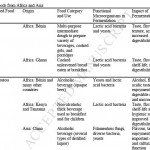Thanks to the NY Times’ photography blog Lens, two great multimedia presentations for you, both on a watery theme, but with some agrobiodiversity thrown in. From Panos, a moving video of the story of how Tuvaluans are trying — and, alas, mainly failing — to cope with climate change. It’s getting harder and harder to maintain the way of life, including the taro and pulaka gardens, in the face of rising water levels. But the alternative, life in New Zealand, is not appealing to everyone. And from the other side of the world, illustrating the opposite problem, a photoessay on Iraq’s Marsh Arabs, who live by fishing, growing a few crops, and raising buffaloes. But “farmers say lowered water levels and pollution has made it difficult to keep the buffalo healthy.”
Japanese agrobiodiversity art
Adam at Mutantfrog Travelogue, which seems to be a blog about things Japanese, has a post about a craft called Mizuhiki (水引). This involves the decorative use of twine made from a special kind of traditionally-produced paper called Washi or Wagami (和紙). Washi is made from all kinds of different agrobiodiversity:
Washi is commonly made using fibers from the bark of the gampi tree, the mitsumata shrub (Edgeworthia papyrifera), or the paper mulberry, but also can be made using bamboo, hemp, rice, and wheat.
That “gampi tree” gave me a bit of trouble, but I finally ran it to ground. It seems to be Wikstroemia sikokiana in the Thymelaeaceae. The paper looks beautiful. Anyway, in researching all this I came across a little gem:
In 1869 the then Prime Minister, William Gladstone, requested a report on Japanese paper and papermaking from the British Embassy in Japan. A thorough investigation was carried out by Sir Harry Parkes and his team of consular staff in different Japanese towns, resulting in the publication of a government report, “Reports on the manufacture of paper in Japan“, and the formation of a collection of 400+ sheets of handmade paper. The main parts of this collection are now housed in the Paper Conservation Laboratory of the Victoria and Albert Museum, and the Economic Botany Collection of the Royal Botanic Gardens, Kew. In 1879 Kew sent duplicate samples to Glasgow, Sydney, Melbourne and Adelaide, but these have been lost. The Parkes paper collection is important because the origin, price, manufacturing method and function of each paper was precisely documented.
Something to check out the next time I’m in London.
Nibbles: Potatoes, Tortillas, EU agricultural promotion, Human diversity, Children
- Potato fest at the Vavilov Institute next week. Report for us!
- Gary Nabhan on tortillas made of “mesquite pods, the flour of ground, popped amaranth seeds, wheat flour and olive oil.”
- EU to fund promotion of agricultural products, including information campaigns on the EU system of PDO, PGI, TSG, QWPSR et al. Via.
- Diversity good even within individuals.
- Engaging children in Sahelian agriculture and agrobiodiversity.
Forays in fermentation
![]()
There’s a couple of interesting articles about cereal fermentation in the latest Food Microbiology. Both basically say that fermentation is a useful way of getting more nutrition out of your staples. Rob Nout 1 describes how various traditional fermented dishes are made in Africa and Asia, ranging from kenkey in Ghana to idli in Sri Lanka. The former is made from maize, the latter from rice. Here’s the part of the paper’s Table 1 which lists fermented foods made from maize and sorghum (pearl millet, finger millet and rice are also considered):
It can get complicated. Here’s how they make jnard in India (I’ve removed the references to ease the flow), for example:
Jnard is an opaque beer made from finger millet (Eleusine coracana). Although – judging by its description – it would seem similar to Tchoukoutou, its mode of processing is fundamentally different. Whereas Tchoukoutou is brewed from sorghum malt, Jnard is saccharified by the action of an indigenous amylolytic starter (Murcha) on previously soaked and cooked fingermillet paste. Murcha is a rice-based dried tablet containing a mixed microflora of filamentous fungi, yeasts and lactic acid bacteria, and differs from koji which is a concentrate of fungal conidia of e.g. Aspergillus oryzae, used in the preparation of soya sauce and similar products. The process of preparing Jnard includes an overnight soak of finger millet seeds to soften them, grinding to obtain a crushed mass which is cooked and cooled to about 30ºC. Then, pulverized Murcha is sprinkled in the cooked mass and during a 1-3 day incubation, saccharification, lactic fermentation and alcoholic fermentation take place simultaneously. Functional microorganisms of Murcha and similar Asian amylolytic starters are filamentous fungi (Amylomyces rouxii, Rhizopus oryzae, etc.) which produce a range of enzymes including glucoamylase that degrades starch directly into glucose; yeasts (Endomycopsis fibuligera, Saccharomyces cerevisiae, etc.) which ferment part of the glucose produced; and lactic acid bacteria (Enterococcus faecalis, Pediococcus pentosaceus and others) growing together with the yeasts. LAB are able to co-exist with yeasts in a protocooperative manner.
Nibbles: Camel, Maya forestry, Ancient barley, Cattle diversity, Poisons, Agroforestry Congress, Lactase persistence
- Wild camel genetically distinct from the domesticated kind. Well I never.
- Maya tapped into their “sacred groves” to build temples, which did not end well.
- Boffins extract DNA from ancient barley in Upper Egypt, find it was 2-rowed, but derived from a 6-rowed ancestor. No word on whether it was used to make beer, but my guess is yes.
- Large Y chromosome microsatellite study of Eurasian cattle does “not support the recent hypothesis on the origin of Y1 from the local European hybridization of cattle with male aurochsen.” This could run and run.
- I like this idea: a garden of poisons.
- Agroforestry’s coming-of-age party coming up. You going? Let us know.
- Multiple explanations for lactase persistence.
